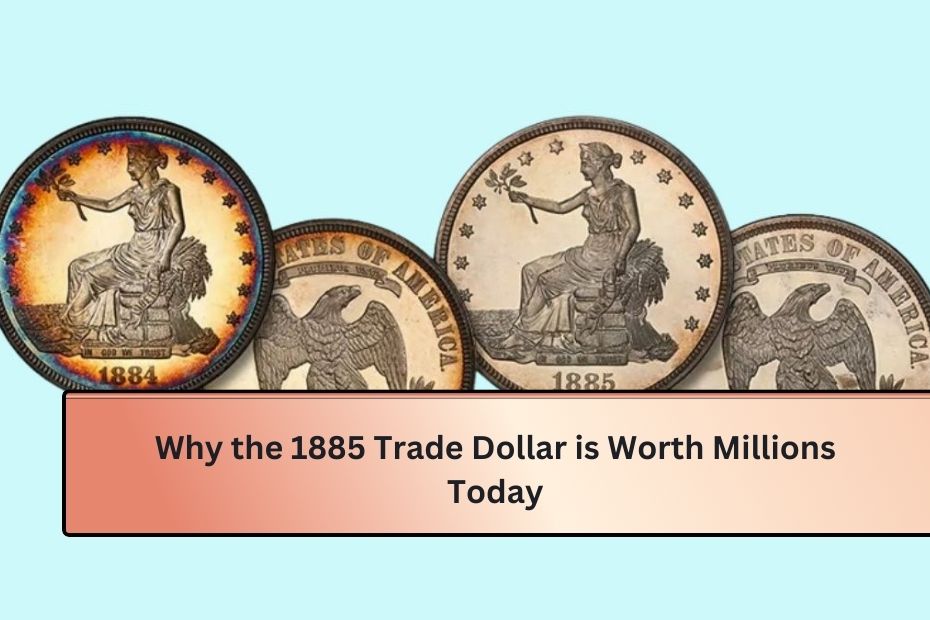The 1885 Trade Dollar is a rare and valuable piece of American history. It stands out because it was never meant for general circulation. Instead, it was minted as a proof coin, intended for collectors. Only five of these coins were ever produced, making it one of the most sought-after trade dollars in the world. The trade dollars were originally designed to help American traders in Asia, but the 1885 version was purely for collectors. Its rarity, historical significance, and beauty make it a prized possession for numismatists.
What is a Trade Dollar?
Trade Dollars were introduced in 1873, primarily for international trade, particularly with China. American merchants needed coins with a high silver content that were easily accepted overseas. The Trade Dollar, weighing 27.22 grams and containing 0.7874 troy ounces of silver, was heavier than the standard silver dollar at the time, making it more attractive in foreign markets.
The U.S. Mint produced millions of these coins from 1873 to 1878. However, due to their heavy use abroad, many Trade Dollars didn’t remain in the United States. The 1885 Trade Dollar, however, was unique because it was made after the U.S. had already stopped producing trade dollars for general circulation.
The Rarity of 1885 Trade Dollar
In 1885, the U.S. Mint produced only five proof Trade Dollars, and none of them were intended for circulation. Proof coins are specially made for collectors, struck with greater care and precision, and have a mirror-like finish. These five coins were likely produced as a test or as a special offering to elite collectors.
Given that only five coins were made, their value is incredibly high today. The 1885 Trade Dollar is considered one of the rarest and most valuable American coins, with each of the surviving examples worth millions of dollars.
Design and Specifications
The 1885 Trade Dollar features the same design as other trade dollars of the era. The obverse (front) of the coin shows Lady Liberty seated on a bale of goods, holding an olive branch, symbolizing peace. The reverse (back) of the coin features an eagle with a shield on its chest, holding arrows and an olive branch in its talons, symbolizing the balance between war and peace.
Here are the specifications for the 1885 Trade Dollar:
| Specification | Details |
|---|---|
| Year | 1885 |
| Mintage | 5 (Proof Only) |
| Composition | 90% Silver, 10% Copper |
| Weight | 27.22 grams |
| Diameter | 38.1 mm |
| Edge | Reeded |
| Designer | William Barber |
Value and Auction Prices
Given the extreme rarity of the 1885 Trade Dollar, the price for one of these coins can easily reach into the millions of dollars. The few examples that exist are typically sold through auctions, with some fetching prices upwards of $3 million. The value of a coin can vary depending on its condition, but even lower-grade examples command astronomical prices due to their historical significance and rarity.
Why Was the 1885 Trade Dollar Not Circulated?
The 1885 Trade Dollar was minted long after the production of trade dollars for circulation had ceased. By this time, the U.S. government had demonetized Trade Dollars, meaning they were no longer legal tender in the U.S. The coins produced in 1885 were likely made as collector’s items rather than for practical use in trade.
Conclusion
The 1885 Trade Dollar is a piece of American history, with only five coins ever produced. Its rarity, coupled with its stunning design and historical significance, makes it a coveted item for collectors. These coins have fetched millions at auctions, and their value only continues to grow as they become more scarce. For anyone interested in numismatics, the 1885 Trade Dollar remains a symbol of both rarity and craftsmanship.
TWH News Home
FAQs
1. Why is the 1885 Trade Dollar so valuable?
The coin is valuable due to its extreme rarity—only five were ever made—and its historical significance as a proof-only coin.
2. How much is an 1885 Trade Dollar worth today?
The value can vary, but these coins have been sold at auction for as much as $3 million or more, depending on their condition.
3. Were Trade Dollars legal tender in the U.S.?
Trade Dollars were originally legal tender up to $5, but they were demonetized in 1876, meaning they could no longer be used as money within the U.S.
4. Why were Trade Dollars produced in the first place?
Trade Dollars were produced to facilitate American trade with Asia, particularly China, where they were accepted due to their high silver content.
5. What is the difference between a proof coin and a regular coin?
Proof coins are specially struck with greater detail and a mirror-like finish, usually for collectors. They are not intended for general circulation like regular coins.

